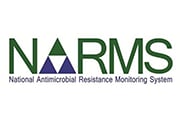NARMS in Action
NARMS is the National Antimicrobial Resistance Monitoring System.

The Clinical and Laboratory Standards Institute published azithromycin breakpoints for Shigella, based on research findings by CDC scientists and partners. This means clinical labs can now test whether Shigella causing a patient’s illness is resistant to azithromycin. This breakthrough will improve patient care and decision-making about antibiotics.
Learn more about this important development, the extensive research and collaboration that went into it, and how it helps doctors and their patients.

Scientists from CDC, FDA, and USDA published an article that describes how the first two decades (1996–2016) of NARMS contributed to our understanding of antimicrobial resistance in bacteria transmitted commonly through food and shows how such a program can have broad positive impacts on public health. Technologies, such as whole genome sequencing, are providing an unprecedented level of detail about bacteria that help NARMS track resistance trends and mechanisms, and also help solve outbreaks caused by resistant bacteria. Learn more about how NARMS uses a collaborative, One Health approach to monitor antimicrobial resistance and conduct applied research.

CDC estimates that Salmonella bacteria cause 1.35 million human illnesses in the United States every year. Most people get better quickly, but the outcome can be worse for those infected with Salmonella Dublin, a type of Salmonella usually found in cattle. Salmonella Dublin causes rare but severe disease in humans. Salmonella Dublin illnesses in the United States have been linked to raw dairy products and beef products. In the last decade, more than half of Dublin infections have been resistant to seven antibiotic classes and clinical outcomes have worsened.
In this study, CDC investigators use data from NARMS to track resistant Salmonella Dublin infections in people. Learn more about how Dublin infections have increased in incidence, antimicrobial resistance, and clinical severity.

Antimicropial resistance in other parts of the world affects treatment options in the United States. Two studies explore this link for Salmonella resistant to quinolones, a class of antibiotics commonly used to treat Salmonella infections:
- The first study examined the global story of emerging and highly resistant Salmonella serotype Kentucky. Salmonella Kentucky’s resistance to antibiotics has been reported in patients from Europe, most of whom had traveled to Africa and the Middle East. Learn about ciprofloxacin-resistant Salmonella Kentucky causing illness among people in the United States who acquired infections while traveling.
- The second study used surveillance data to determine that Salmonella serotype Enteritidis infections resistant to quinolone antibiotics are associated with recent international travel. Learn how this analysis broadens our understanding of infection sources.

It can be difficult to find the source of a foodborne outbreak, especially when the outbreak is caused by Salmonella serotype Typhimurium, which can contaminate many different kinds of foods. This study looked at the genes that code for antimicrobial resistance in Typhimurium and the plasmids (structures inside some cells that can carry and spread resistance genes) that carry them as clues about the sources of outbreaks.
The authors examined resistance plasmids found in Salmonella Typhimurium isolated from retail meat, food animals, and humans. They found one type of plasmid in chicken and a different one in beef, but both types of plasmids were found in Typhimurium causing human infections. This shows that the type of plasmid may provide clues into the source of human infections. Learn more about this study that demonstrates how bacterial genetic testing can help disease detectives find the source of an outbreak and stop it in its tracks.

Antimicrobials should not be used unnecessarily on the farm, in hospitals, or in other healthcare settings. For years, public health experts have warned about the consequences of antimicrobial overuse and growing antimicrobial resistance.
The inappropriate use of antimicrobials in humans and food animals in addition to other factors can result in resistant bacteria, which can cause more severe patient outcomes. Read a study showing that people who get ill from antimicrobial-resistant strains of Salmonella are more likely to have severe outcomes and to be hospitalized for their illness.